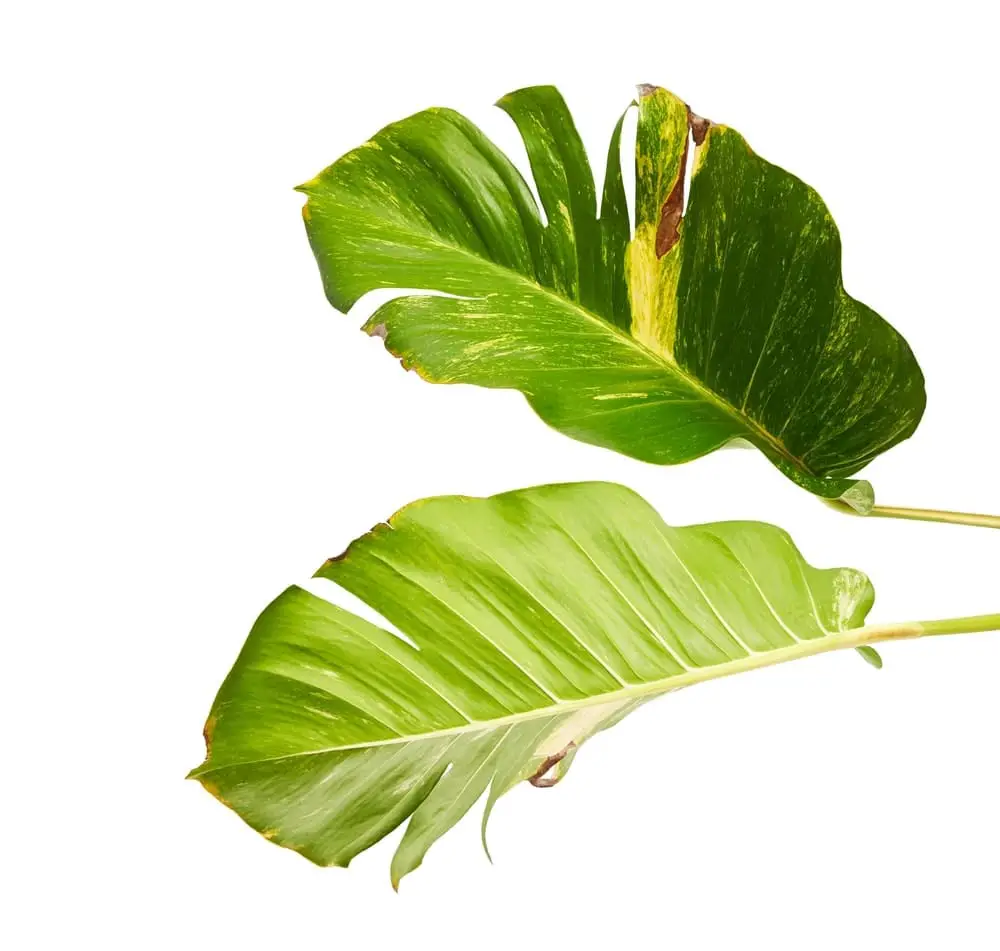The Pothos, also called the Money Plant or the Devil’s Ivy, is a hardy plant often mistaken for the Philodendron.
It is one of the simplest indoor plants to grow. Even people who serially forget to water their plants can keep a Pothos plant alive, which makes them very appealing as houseplant. They are often found in hanging baskets and they have waxy deep green leaves shaped like hearts splashed with color white, yellow, and pale green.
Though easy to care for, Pothos plants can still experience occasional problems. If your Pothos plant’s leaves are turning yellow, this could be caused by a few things. You will need to find the source of the problem first, in order to restore your plant to good health.
The Pothos Plant
Native to Southeast Asia, the Pothos plant is frequently confused with the Philodendron, as their appearance is similar. There are many varieties, two of the most common being the Marble Queen, with which has the widest away of color variations, and the Tricolor, which displays in shades of green, dark yellow, and cream. Given the proper support systems they can climb to great heights and outside will often climb the tallest trees as they grow. Even indoors, they can be trained to grow in vines up to 30 feet. They are also extremely easy to propagate, so it’s a great choice for those looking to fill their home with beautiful plants to cleanse the air.
Widely considered one of the best houseplants for those lacking a green thumb, they thrive in indirect light, thrive in a wide range of temperatures, and are very drought resistant. All parts of the Pothos are poisonous to both humans and animals due to calcium oxalate crystals, so keep them away from kids and pets.
Why Philodendron Plants Gets Yellow Leaves
Despite being very hardy, there are still several reasons why a Philodendron’s leaves might begin to turn yellow and wilt.
1. Moisture
Pothos plants do best if the soil they are planted in is allowed to dry out completely before they are watered again. They can thrive for long periods of time between waterings. They are very susceptible to over watering, which can cause the plants to rot, resulting in drooping and spotted leaves.
2. Pests
Pothos plants are remarkably resistant to most common pests, however they can become infested by mealy bugs.
3. Becoming Pot Bound
Pothos plants become pot bound when their roots have grown to a size where they fill the entire pot. This causes the plants leaves to droop and become discolored.
4. Temperature
Though very resilient plants, there is still a level of temperature that the Pothos cannot thrive in. They do best in a temperature between 65 – 70 degrees F but can survive as low as 50 degrees F.
5. Light
Pothos plants do best in bright indirect light. Without enough like, they will often lose their leaf pattern. Alternatively, plants placed in direct sunlight will often suddenly exhibit very leaves.

Treatments
Moisture:
- Pothos plants do best when soil is dry before they are watered again. They can go longer without water longer in the winter.
- You can judge when a Pothos plant is ready to be watered by looking at it and feeling the soil. If the soil is dry and the plant looks as if it is beginning to wilt, it is time for a watering.
- Do not wait until the soil is bone dry, as alternating between bone dry soil and soaking your plant can cause it stress. This is one of the biggest reasons for yellowing of Pothos leaves.
- Create a watering schedule once you have determined a good routine. By following a schedule, you can make sure that you do not over or under water your plant.
Pests:
- Pothos plants are typically pest free except for mealy bugs.
- If you see mealy bugs on your plant, carefully remove the pests.
- Use a gentle natural insecticide soap on the leaves of your plant to keep them mealy bug free.
More like this: Yellow Money Tree Leaves – Treatments
Becoming Pot Bound:
- If you are watering on a regular schedule and a plant that has previously been doing well is consistently wilting and yellow, it may be have outgrown its pot.
- Carefully lift the plant to see if the roots have extended to the edges of the pot.
- Repot in a container one or two sizes larger than the original.
- Use fresh soil whenever you repot a plant.
Temperature:
- If you are keeping your Pothos plant outdoors, bring it in whenever the temperature is expected to drop below 55-degrees F.
- Don’t keep plants near windows and doors that will be frequently opened to allow cold air in.
Lighting Issues:
- Ensure your plant is getting enough light by placing it in a room that gets plenty of natural light.
- Avoid placing your plant in areas that get a lot of direct sunlight.
How to Take Care of the Yellow Leaves
Yellow Pothos leaves will typically resolve on their own after the stressors that led to the yellowing are resolved. This can take some time. If the leaves do not appear to be resolving, you can gently trim them back to remove the yellow leaves.
Some yellowing of leaves is always to be expected. When new growth forms on a plant, older growth tends to first yellow, then drop away. This is normal and if your plant appears to be otherwise healthy is not a cause for concern.
Keep reading: Yellow Arrowhead Plant Leaves – Reasons & Treatments
Conclusion
The very hardy and drought tolerant has become a popular houseplant due to its ability to survive in less than ideal conditions. The most common cause of yellowing and spotting of the leaves are watering and sunlight related. By ensuring your water on a regular schedule, not erratically, and keeping your plant in a place with sample sunlight, you’ve taken the two most important steps to preventing future issues.
If you do these things, your hardy Pothos plant will thrive in your house for many years and be very healthy.
Also read:
- Yellow Monstera Leaves – Reasons & Treatments
- Yellow Dracaena Leaves – Reasons & Treatments
- Yellow Money Tree Leaves – Treatments
Victoria is the owner and main author of hobby plants. She loves spending her free time in her garden planting and taking care of her plants. Victoria hopes you enjoy the content here!
![How To Propagate Pothos? [COMPLETE BEGINNER'S GUIDE] How To Propagate Pothos? [COMPLETE BEGINNER'S GUIDE]](https://www.hobbyplants.com/wp-content/uploads/2022/07/how-to-propagate-pothos-300x158.jpg)
![How Often Should You Water Pothos? [Complete Care Guide] How Often Should You Water Pothos? [Complete Care Guide]](https://www.hobbyplants.com/wp-content/uploads/2022/07/how-often-to-water-pothos-300x158.jpg)
![Why Are My Orchid Leaves Turning Yellow? [Find Out Here] Why Are My Orchid Leaves Turning Yellow? [Find Out Here]](https://www.hobbyplants.com/wp-content/uploads/2022/07/orchid-leaves-turning-yellow-300x158.jpg)

![Why Is My Bamboo Plant Turning Yellow? [Find Out Here] Why Is My Bamboo Plant Turning Yellow? [Find Out Here]](https://www.hobbyplants.com/wp-content/uploads/2022/07/why-is-my-bamboo-turning-yellow-300x158.jpg)
![Why Is My Fiddle Leaf Fig Dropping Leaves? [ANSWERED] Why Is My Fiddle Leaf Fig Dropping Leaves? [ANSWERED]](https://www.hobbyplants.com/wp-content/uploads/2022/06/why-is-my-fiddle-leaf-fig-dropping-leaves-300x158.jpg)
![Why Are My Bird of Paradise Leaves Curling? [FIND OUT HERE] Why Are My Bird of Paradise Leaves Curling? [FIND OUT HERE]](https://www.hobbyplants.com/wp-content/uploads/2022/07/bird-of-paradise-leaves-curling-300x158.jpg)
![Why Are My Peace Lily Leaves Turning Brown? [EXPLAINED] Why Are My Peace Lily Leaves Turning Brown? [EXPLAINED]](https://www.hobbyplants.com/wp-content/uploads/2022/07/peace-lily-leaves-turning-brown-1-300x158.jpg)
